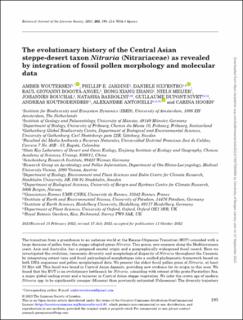| dc.contributor.author | Woutersen, Amber | |
| dc.contributor.author | Jardine, Phillip E | |
| dc.contributor.author | Silvestro, Daniele | |
| dc.contributor.author | Bogotá-Angel, Raul Giovanni | |
| dc.contributor.author | Zhang, Hong-Xiang | |
| dc.contributor.author | Meijer, Niels | |
| dc.contributor.author | Bouchal, Johannes | |
| dc.contributor.author | Barbolini, Natasha | |
| dc.contributor.author | Dupont-Nivet, Guillaume | |
| dc.contributor.author | Koutsodendris, Andreas | |
| dc.contributor.author | Antonelli, Alexandre | |
| dc.contributor.author | Hoorn, Carina | |
| dc.date.accessioned | 2023-09-27T10:42:12Z | |
| dc.date.available | 2023-09-27T10:42:12Z | |
| dc.date.created | 2023-09-20T13:09:52Z | |
| dc.date.issued | 2023 | |
| dc.identifier.issn | 0024-4074 | |
| dc.identifier.uri | https://hdl.handle.net/11250/3092338 | |
| dc.description.abstract | The transition from a greenhouse to an icehouse world at the Eocene-Oligocene Transition (EOT) coincided with a large decrease of pollen from the steppe-adapted genus Nitraria. This genus, now common along the Mediterranean coast, Asia and Australia, has a proposed coastal origin and a geographically widespread fossil record. Here we investigated the evolution, taxonomic diversity and morphological disparity of Nitraria throughout the Cenozoic by integrating extant taxa and fossil palynological morphotypes into a unified phylogenetic framework based on both DNA sequences and pollen morphological data. We present the oldest fossil pollen grain of Nitraria, at least 53 Myr old. This fossil was found in Central Asian deposits, providing new evidence for its origin in this area. We found that the EOT is an evolutionary bottleneck for Nitraria, coinciding with retreat of the proto-Paratethys Sea, a major global cooling event and a turnover in Central Asian steppe vegetation. We infer the crown age of modern Nitraria spp. to be significantly younger (Miocene) than previously estimated (Palaeocene). The diversity trajectory of Nitraria inferred from extant-only taxa differs markedly from one that also considers extinct taxa. Our study demonstrates it is therefore critical to apply an integrative approach to fully understand the plant evolutionary history of Nitrariaceae. | en_US |
| dc.language.iso | eng | en_US |
| dc.publisher | Oxford University Press | en_US |
| dc.rights | Navngivelse-Ikkekommersiell 4.0 Internasjonal | * |
| dc.rights.uri | http://creativecommons.org/licenses/by-nc/4.0/deed.no | * |
| dc.title | The evolutionary history of the Central Asian steppe-desert taxon Nitraria (Nitrariaceae) as revealed by integration of fossil pollen morphology and molecular data | en_US |
| dc.type | Journal article | en_US |
| dc.type | Peer reviewed | en_US |
| dc.description.version | publishedVersion | en_US |
| dc.rights.holder | Copyright 2023 The Author(s) | en_US |
| cristin.ispublished | true | |
| cristin.fulltext | original | |
| cristin.qualitycode | 1 | |
| dc.identifier.doi | 10.1093/botlinnean/boac050 | |
| dc.identifier.cristin | 2177075 | |
| dc.source.journal | Botanical journal of the Linnean Society | en_US |
| dc.source.pagenumber | 195-214 | en_US |
| dc.identifier.citation | Botanical journal of the Linnean Society. 2023, 202 (2), 195-214. | en_US |
| dc.source.volume | 202 | en_US |
| dc.source.issue | 2 | en_US |

